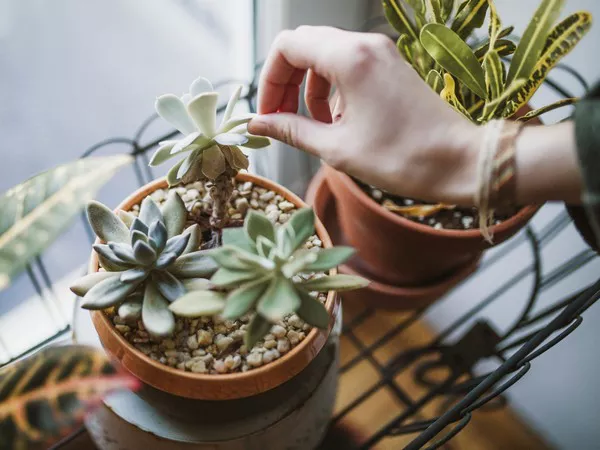Succulents, with their unique and captivating appearance, have become a favorite among plant enthusiasts and homeowners alike. These hardy plants are known for their ability to store water in their fleshy leaves and stems, making them resilient in arid conditions. While their striking shapes and colors are a primary attraction, witnessing succulents in bloom adds another layer of fascination to their allure.
The Nature of Succulents
Succulents, a diverse group of plants belonging to various botanical families, share a common characteristic – the ability to store water in their tissues. This adaptation allows them to thrive in environments where water is scarce, making them well-suited for arid climates. The term “succulent” itself is derived from the Latin word “sucus,” meaning juice or sap, emphasizing the plant’s capacity to retain moisture.
Succulents in the Garden Landscape
In landscaping and interior decor, succulents have gained popularity for their versatility and low-maintenance requirements. Their unique shapes, ranging from the rosettes of echeverias to the cylindrical columns of cacti, make them an aesthetic choice for gardens, terrariums, and even as houseplants. The resilience of succulents to survive with minimal water makes them an ideal addition to various settings.
The Intriguing Process of Succulent Flowering
While succulents are primarily admired for their striking foliage, the emergence of flowers adds a fascinating dimension to their beauty. The process of succulent flowering is triggered by various factors, with environmental conditions playing a significant role. Unlike many conventional flowering plants, succulents often bloom in response to specific stimuli, such as changes in daylight, temperature, or even periods of drought.
Understanding the Role of Environmental Factors
Succulents are highly responsive to environmental cues when it comes to flowering. The availability of sunlight, temperature fluctuations, and seasonal changes can influence the onset of flowering in these plants. Many succulents, including those belonging to the Echeveria and Kalanchoe genera, exhibit a tendency to flower in response to increased daylight hours during certain times of the year.
Adaptations for Survival
The process of succulent flowering can be seen as an adaptive mechanism for survival. In their native habitats, where resources may be limited, succulents utilize flowering as a strategy to propagate and ensure the continuation of their species. The production of vibrant flowers attracts pollinators, such as bees and butterflies, facilitating the transfer of pollen and the subsequent development of seeds.
Variety in Succulent Flowers
Succulent flowers come in a wide array of shapes, sizes, and colors, adding to the diversity of these already fascinating plants. From the delicate and dainty blooms of the Haworthia to the bold and vibrant flowers of the Aloe, each succulent species showcases its unique floral display. This diversity not only enhances the visual appeal of succulents but also offers enthusiasts a rich tapestry to explore within the realm of these resilient plants.
The Impact of Succulent Flowering on Plant Health
Contrary to common misconceptions, the act of flowering does not necessarily indicate a decline in the health of succulents. In fact, for many species, flowering is a natural and healthy part of their life cycle. It signifies that the plant has reached a level of maturity where it is ready to produce seeds and contribute to the next generation. However, it is crucial to strike a balance, as excessive flowering and seed production can potentially divert energy away from the growth and maintenance of the plant itself.
Caring for Flowering Succulents
Proper care during the flowering phase can ensure the longevity of both the flowers and the succulent itself. Adequate sunlight, well-draining soil, and appropriate watering practices contribute to the overall well-being of flowering succulents. It’s essential to monitor the plant’s response to flowering, as some species may benefit from a slight adjustment in care to support the additional energy demands associated with the blooming process.
Pruning and Maintenance
After the flowering phase concludes, succulent enthusiasts may choose to engage in pruning to maintain the plant’s shape and encourage future growth. Pruning spent flowers and any damaged or dead leaves not only enhances the plant’s aesthetic appeal but also redirects its energy towards producing new growth. This practice is particularly relevant for succulents cultivated in containers or small garden spaces.
Propagation through Succulent Flowers
Succulent flowers play a pivotal role in the propagation of these resilient plants. Once pollinated, the flowers develop into seed pods containing numerous seeds. Enthusiasts keen on expanding their succulent collection can collect these seeds and propagate new plants. While propagation from seeds may require patience and careful attention, it offers a rewarding experience as individuals witness the entire lifecycle of the succulent from seed to mature plant.
Succulents in Seasonal Bloom
Understanding the seasonal patterns of succulent flowering enhances the appreciation for these resilient plants. Many succulents follow distinct blooming seasons, with some species showcasing their vibrant flowers in spring or summer, while others may prefer the cooler months of fall or winter. Observing the seasonal rhythms of succulent flowering adds an element of anticipation and excitement for enthusiasts eager to witness the beauty of nature unfold.
Conclusion
In conclusion, the flowering of succulents is a captivating and natural occurrence that adds a layer of beauty and complexity to these already remarkable plants. From the arid landscapes where succulents thrive to the gardens and homes where they are cultivated, the emergence of vibrant flowers signifies not only the health and maturity of the plant but also its contribution to the cycle of life. As succulent enthusiasts embrace the diverse array of shapes, sizes, and colors that succulent flowers offer, they gain a deeper understanding of the intricate relationship between these resilient plants and the environments they inhabit. So, the next time you witness your succulent gracing you with its blossoms, take a moment to appreciate the natural wonder unfolding before your eyes, a testament to the adaptability and beauty of these unique botanical wonders.


